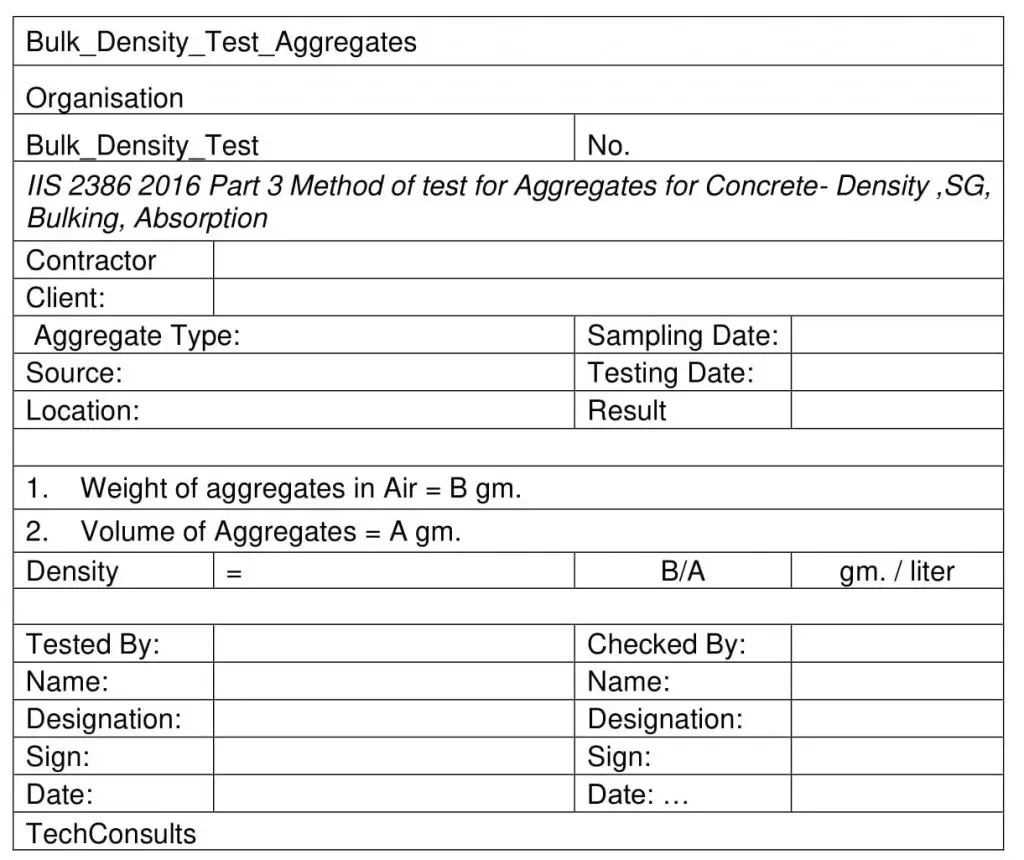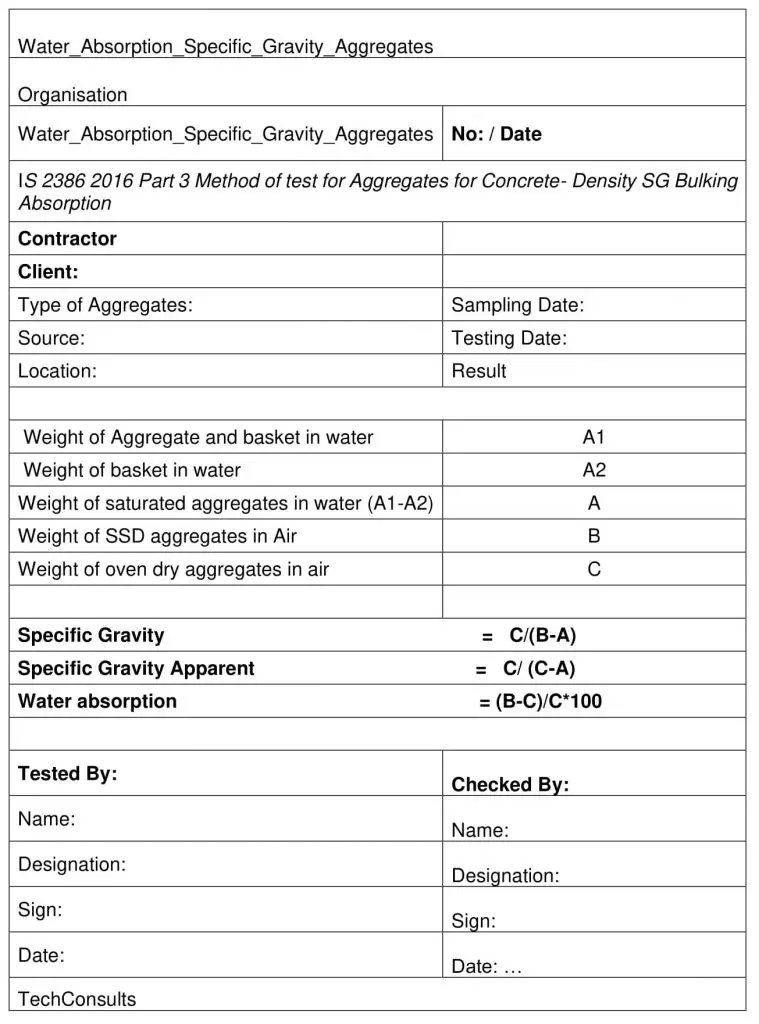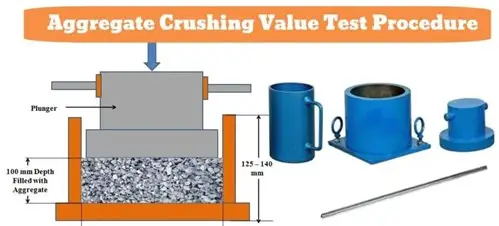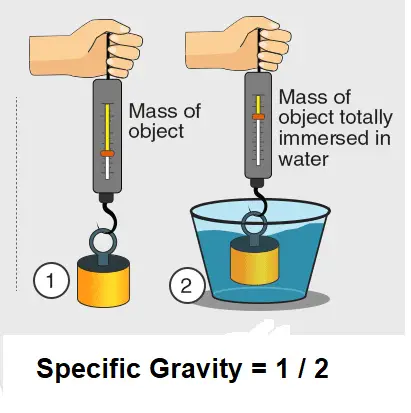Tech Consults SK 56
General
(IS 2386 2016 Part 3 Method of test for Aggregates for Concrete- Part- III Specific Gravity, Density, Voids Absorption and Bulking.)
This method covers the procedure for determining unit weight or bulk density, Specific Gravity, Density, Voids, Absorption and Bulking of aggregate.
Bulk density of Aggregates
The bulk density of an aggregate =Mass of aggregates / Volume of Aggregates (Volume of the Container) Kg / litter
The aggregates are placed and compacted in container. The compaction depends on the shape of the aggregates.
Flaky, elongated shaped particles affect the compaction process and ultimate affect on value of the bulk density. If the bulk density is less, it is due to such unwanted shape particles. The percentage of such particles should not be more than 15 to 20 percent
Apparatus for Bulk density Test:
Balance
Cylindrical Measure as follows:
Size of Aggregates mm | Volume of Container Liter | Tamping Rod Size mm |
<4.75 mm | 3 | 3.15 |
4.75 – 40 mm | 15 | 4.0 |
Over 40 mm | 30 | 5.0 |
Tamping rods of sizes as above
Test procedure for testing Bulk Density of aggregates
The designated container is filled in three layers (volume is known) in liters as A
Each layer is compacted with 25 strokes of the designated rod size.
The net weight of aggregate is determined. (weight is known in kg) as B
Bulk density= B/ A Kg per liter and can be converted to other units such as Kg per cubic mete
Bulk Density of Aggregates – Test Format

Note:
Test covers the fine and coarse aggregates classified as below:
Less than 4.75 mm.
4.7m mm to 40 mm and
above 40 mm.
Accordingly, the code suggests the different volume measures (5, 15, 30) liters respectively, and their size along with the sizes of the temping rod, as given in table above under the heading apparatus.
———————————-
Water Absorption and Specific Gravity of Aggregate
General
(IS 2386 2016 Part 3 Method of test for Aggregates for Concrete- Density SG Bulking Absorption)
Three main methods are specified for use according to whether
the size of the aggregate is larger than 10 mm (Method I) between 40
and 10 mm (Method I or II may be used); or smaller than 10 mm (Method III).
An alternate method (Method IV) is also permitted.
The specific gravity (SG) of an aggregate = mass of solid in each volume of sample / mass of an equal volume of water at the same temperature. It is a number.
(when a substance is immersed in water, then it loses its weight and the loss of weight in water is equal to volume of water displaced)
The value of SG of aggregate ranges from 2.6 to 3.0. Below this value the aggregates have less strength and may not be used in structural concrete. The changes in value of SG depends on the quality of aggregates such as shape and internal grading.

The aggregate generally contains voids, there are different types of specific gravities.
The absolute or complete SG, the denominator of the definition of SG the volume of solid material excluding the voids
Absolute SG = mass of solid to the weight / equal void-free volume of water at a stated temperature.
If,
A= the weight in of the saturated aggregate in water (A1 – A2) as detailed
in calculation sheet
B = the weight of the saturated surface-dry (SSD) aggregate in air, and
C= the weight in of oven-dried aggregate in air.
Specific gravity Bulk = C / B – A
Apparent specific gravity = C / C – A
Water Absorption and Specific Gravity of Aggregate > 10 mm _ test
Procedure
A 2000 gm of aggregate shall be thoroughly washed and placed in the wire basket and immersed in water at the temperature of 220 C to 320 C for 24 hrs.
After that basket and the sample shall be jolted / shake and weigh in the water (Let it be A1 units = weight of basket and aggregates in water).
After that, the aggregate shall be removed from the water and allowed to drain for 5 minutes. The aggregate then be dried with dry cloth and the weighed (Let it be B units = weight of SSD aggregates).
Weigh the basket in the water (A2).
The aggregate shall then be placed in the oven at the temperature at 100 -1100 C for 24 hrs. Weigh the aggregates (Let it be C units).
Specific gravity = C / B – A
Apparent specific gravity = C / C – A
Water Absorption
Water absorption is the amount of water absorbed by the aggregate. It is the amount of water retained by the aggregate in saturated surface dry condition (SSD).
Dry a sample of aggregate to 100 degree centigrade till constant weight is obtained (Let it be C units).
Wet the sample for 24 hours. Surface dry it and weigh it. (Let it be B units).
Water absorption (percent of dry weight) = 100 * (B –C) / C
Water Absorption and SG of Aggregates – Test Format

Water Absorption and Specific Gravity of Aggregate
< 10 mm _ test Procedure
Pycnometer Method
Sample size:
1.0 Kg – for Aggregates 4.75mm to 10 mm and ).
0.5 Kg – for aggregates finer than 4.75 mm.
Put the sample for 24 hours in water at 22 to 32 degree C temperature.
The sample is taken out and drained and is put to SSD conditions and weighed. Let it be A
Fill water in pycnometer and add aggregates to it. Shake it to remove air entrapped. The pycnometer now has aggregates and water above it. Maintain a certain level and put a mark on pycnometer.
Find the weight of Pycnometer + aggregates+ water> Let it be B.
Empty the pycnometer over an arrangement to drain out the water and keep the aggregates in oven at 110 degree centigrade. Let this oven dry weight be D.
Refill it with water up to marked level.
Find weight of pycnometer + water. Let it be C.
Calculations
Specific gravity = D / A-(B-C)Apparent specific gravity = D / D – (B-C)Water absorption ( percent of dry weight) = (A-D) / D *100 |
A dry sand has a volume measure. The same quantity of sand in wet condition has more value. The increase in such volume is called Bulking.
Test Method for Bulking of Sand
Take a container and fill it loosely by sand up to two third of height of container. Level the sand contents and measure the depth of fill at center. Let it e = h
Add water in tank to submerge the sand and compact it by rod . Level the sand surface under water and measure the depth of sand in the center. Let it be = H
The bulking of sand = (h – H / H)*100
When wet sand is used at open sites for manufacturing of concrete on volume basis, the bulking percent is used to adjust the quantity of sand.

SK Saxena PMP www.techconsults.in
Additional links.
Flakiness Index Test for Coarse Aggregates for Concrete – TechConsults
Elongation Index Test for Coarse Aggregates for Concrete – TechConsults
Test for Abrasion of Coarse Aggregates Using Los Angeles Machine – TechConsults
https://techconsults.in/test-for-aggregates-for-concrete-aggregate-soundness-test-53/
https://techconsults.in/rock-bolt-anchor-elements-in-situ-pull-out-test-54/





